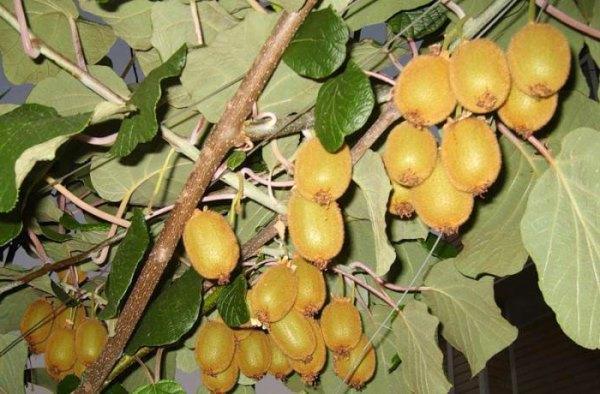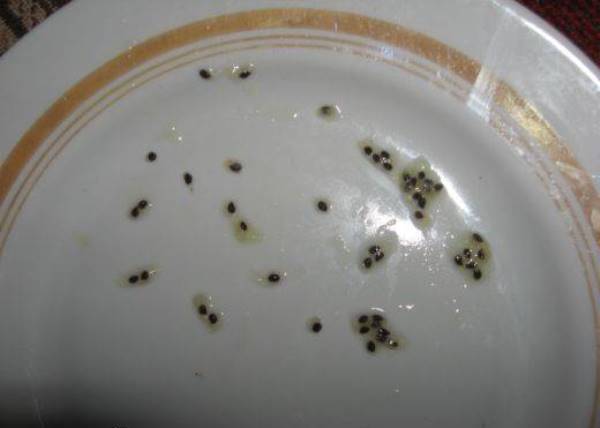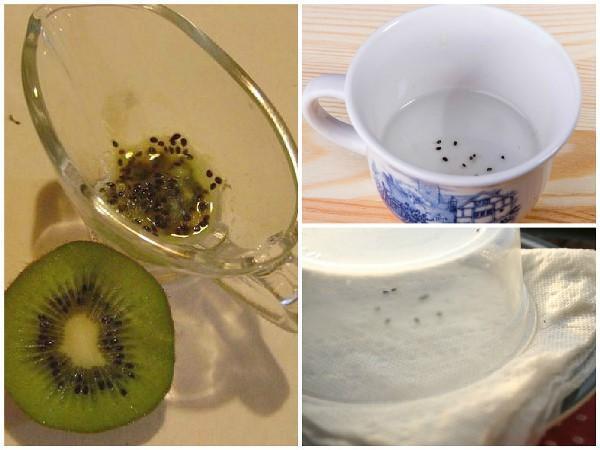Surprise everyone around - plant kiwi at home!
Pears, apples, plums, raspberries are all very good. But you can grow something exotic! Let not in the open field, but on the balcony or in the winter garden. Yes, even in a pot on the windowsill oranges or tangerines, pineapple or kiwi - it's so great!

Kiwi is a creeping vine. She can trudge along the balcony, around special racks. It is both beautiful and practical - the fruits of a plant grown at home can be enjoyed and treated to guests.
Where to get kiwi seeds?
You can find kiwi seeds in online stores, and collect it yourself from purchased fruits. This is done quite simply:

- The ripe fruit is cut in half. You can take both hairy kiwi and smooth-skinned.
- About 20 pieces of small seeds are taken from the middle.
- Having folded the seeds in gauze, tying it with a bag, washed under running water. This procedure must be repeated several times so that there is no pulp left on the planting material. Otherwise, the seeds will rot in the soil.
- The washed seed material is left to dry for several hours. You can spread it out on a clean newspaper and leave it in a dry, windless place (not near an open window, not in the fresh air, not in the refrigerator).

So the seeds of an exotic plant are ready, which can later surprise friends, acquaintances and neighbors.
But why is it recommended to take 20 seeds, and not two or three? Because this culture is dioecious.
There are female and male kiwi plants. This means that in order to subsequently receive the fruits, you need to have both those and others available. It is possible to determine whether this plant is male or female only after it blooms. Therefore, you should plant several sprouts so that you do not suffer from a shortage later.
Germinating Kiwi Seeds
This process will take a whole week. Given the fact that kiwi grows in nature in an area where summer is long and warm, you should start experimenting in early spring, in mid-March.
A cotton pad is moistened with hot water and placed in a saucer. Seeds are laid out on its surface. There should be no water in the saucer.

A saucer with seeds is placed in a plastic bag and tied. It turns out a greenhouse in miniature. Expose the structure to the sun.

At night, the saucer is taken out of the bag, and in the morning, the cotton pad is again moistened with warm water and the seed is hidden under a film.

After the appearance of white sprouts, they are planted.
Soil preparation, planting seeds
The composition of the soil for kiwi is simple: humus, sand, turf and peat mixed in equal proportions and placed in pots. You can use ready-made soil mixtures for vegetable crops by adding sand to them. It is also good to lay expanded clay, fine gravel in pots on the bottom.

It is not recommended to use construction sand - it compacts the soil, making it unsuitable for plant growth.
A seed is spread on the prepared soil. From above it is covered with a thin layer of dry earth. Water the soil very carefully, using a sprayer, so as not to wash off the top soil layer from the seeds. This procedure is performed daily.
It is important to ensure that the soil does not dry out! For kiwi, moisture is hardly the most important factor in growing and bearing fruit.
Domes over the pots made from cut plastic bottles will help protect the soil from drying out.

Kiwi is grown in summer and outdoors. But with the onset of cold weather, the plant needs warmth and additional lighting.Therefore, in the autumn-winter period, walls and a roof are organized around the plantings, heating devices and fluorescent lamps are installed in the "winter garden".
Essential Requirements for Good Growing Kiwi
Consistent daily watering of the plants with the sprinkler is essential for this crop. Having determined once how many clicks of the spray gun provides uniform soil moisture, you should constantly adhere to this figure.

Plants should be placed in the southern part of the house, as they need a lot of light. It is recommended to use fluorescent lamps, since kiwi is a culture of long daylight hours. Serve additional lighting necessary horizontally, not from above.

Once a year it is necessary to feed the vine with vermicompost or compost. The nutrient mixture should be applied in the trenches that form around the sprout. During watering, the nutrients that the kiwi need for growth and fruiting will flow to the roots of the plants.

Once a week in the summer, the culture is fed with a complex of mineral fertilizers.

The top of the vine is periodically pinched, thereby stimulating the growth of lateral processes.

In order for flowers to form fruit, they need pollination. Indoors, there are no insects doing this job. Consequently, the owner of the winter garden must take care of this himself.

We grow kiwi at home. Video